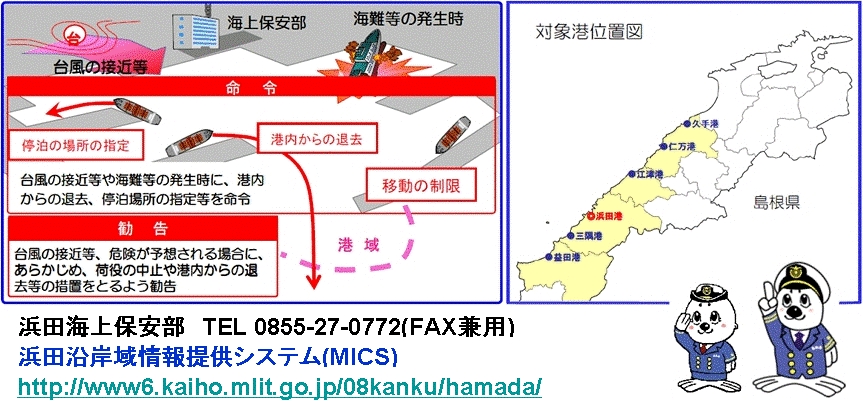気象現況(全国)>第八管区>浜田海上保安部>お知らせ>異常な気象・海象時における対策措置
異常な気象・海象時における対策措置
次の各港では、大型の台風や発達した低気圧、津波等の異常な気象・海象時又は海難等が発生した場合には、港則法第39条第3項及び同法第39条第4項の規定により、浜田港長(浜田海上保安部長)が港内にある船舶等に対して、港内からの退去の命令や避難勧告等を行う場合があります。 対象港: 浜田港、久手港、仁万港、江津港、三隅港、益田港 |
1 各港における台風等対策基準及び措置
|
|||||||||||||||||
1 Disaster countermeasures for typhoon in six ports*
|
|||||||||||||||||
| * "Six ports" are Kute, Nima, Gotsu, Hamada, Misumi and Masuda in the west of Shimane pref. | |||||||||
2 各港における発達した低気圧に対する対策基準及び措置
|
2 Correspondence of development of low pressure in six ports*
|
| * "Six ports" are Kute, Nima, Gotsu, Hamada, Misumi and Masuda in the west of Shimane pref. | |||||||||
3 各港における津波対策基準及び措置
| 津波警報・注意報の種類、 津波の高さ及び警戒体制 (勧告)の種類 |
津波来襲 までの時 間的余裕 |
船 舶 の 対 応 | |||||||
|---|---|---|---|---|---|---|---|---|---|
| 大型船、中型船(漁船を含む) | 小型船 (プレジャーボート、小型漁船等) |
||||||||
| 港内着岸船 | 錨泊船、浮標係留船 (作業船を含む) |
航行船 | |||||||
| 一般船舶 (作業船を含む) |
危険物積載船舶 | 港内着岸船 | 航行船、錨泊船 | ||||||
| 第1警戒体制 | 津波注意報 1m |
荷役・作業中止 係留避泊又は港外退避 | 荷役・作業中止 係留避泊又は港外退避 | 作業中止、港内避泊(場合によっては港外退避) | 港外退避 | 陸揚固縛又は係留強化の後 陸上非難(場合によっては港外退避) | 着岸のうえ陸揚げ固縛若しくは係留強化の後陸上避難又は港外退避 | ||
| 第2警戒体制 | 津波警報 3m |
無し | 荷役・作業中止 係留避泊 | 荷役・作業中止 係留避泊 | 作業中止、港内避泊 | 港内避泊 | 陸上避難 | 着岸後陸上避難又は港内避泊 | |
| 有り | 荷役・作業中止 港外退避又は係留避泊 | 荷役・作業中止 港外退避 | 作業中止、港外退避 | 港外退避 | 陸揚固縛又は係留強化の後 陸上非難(場合によっては港外退避) | 着岸のうえ陸揚げ固縛若しくは係留強化の後陸上避難又は港外退避 | |||
| 大津波警報 5m 10m 10m超 |
無し | 荷役・作業中止 係留避泊又は陸上避難 | 荷役・作業中止 係留避泊又は陸上避難 | 作業中止、港内避泊 | 港内避泊 | 陸上避難 | 着岸後陸上避難又は港内避泊 | ||
| 有り | 荷役・作業中止 港外退避 | 荷役・作業中止 港外退避 | 作業中止、港外退避 | 港外退避 | 陸揚固縛又は係留強化の後 陸上非難(場合によっては港外退避) | 着岸のうえ陸揚げ固縛若しくは係留強化の後陸上避難又は港外退避 | |||
| ※本表による対応にあたっては、人命の安全確保を最優先とする。 | |||||||||
| 【用語の定義等】 | |||||||||
| 津波の来襲までの時間的余裕 | |||||||||
| 有 り : 大津波・津波警報が発せられた時点から避難に要する十分な時間(船舶を港外退避、陸揚げ固縛等の安全な状態に 置くまで)がある場合 |
|||||||||
| 無 し : 大津波・津波警報が発せられた時点から避難に要する十分な時間(船舶を港外退避、陸揚げ固縛等の安全な状態に 置くまで)が無い場合 |
|||||||||
| 大 型 船 : タグボート等の補助船、パイロットを必要とし単独での出港が困難な船舶をいう。 | |||||||||
| 中 型 船 : 大型船及び小型船以外の船舶をいう。 | |||||||||
| 小 型 船 : プレジャーボート、漁船等のうち、港内において陸揚げできる程度の船舶(造船所での陸揚げを含まない)をいう。 | |||||||||
| 陸上避難 : 船舶での退避は高い危険が予想されるので、乗組員等は陸上に避難し、高台等安全な場所に避難する。 可能な限り船舶の流出防止、危険物の安全措置を取る。 |
|||||||||
| 港外退避 : 港外の水深が深く、十分広い海域、沖合いに避難する(港外退避中に航行困難となった場合は港内避泊)。 | |||||||||
| 係留避泊 : 係留強化、機関の併用等により係留状態のまま津波に対抗する(陸上作業員等の緊急避難場所として乗船させる ことも考慮する)。 |
|||||||||
| 陸揚げ固縛 : プレジャーボート、漁船等の小型船を陸揚げし、津波等により海上に流出しないよう固縛する。 | |||||||||
| 係留強化 : スプリング・ブレスト索を長くとる。係留索の増し取り・増し締め等の措置を行う。 | |||||||||
| 【注意事項】 | |||||||||
| 1 VHF装備船は、VHFを聴取すること(国際VHF16ch)。 | |||||||||
| 2 AIS搭載船は、常時AISを作動させ、適正な入力を行うこと。 | |||||||||
| 3 港外退避中の大型船、中型船は、小型船から支援の要請があった場合には、可能な範囲でこれに応じる。 | |||||||||
3 Disaster countermeasures for tsunami in six ports
| Recommendation Category Tsunami Warning/Advisory Height |
Time Allowance to Tsunami Strike | Vessel Types, and Recommended Actions | |||||||
|---|---|---|---|---|---|---|---|---|---|
| Large/Mid-sized Vessels(Including Fishing Vessels) | |||||||||
| In a port Berthing Vessels | Anchoring Vessels/Buoy-mooring Vessels (Including Working Vessels) |
Proceeding Vessels | |||||||
| General Vessels (Including Working Vessels) |
Vessels Carrying Dangerous Cargo | ||||||||
| RECOMMENDATION (1st) |
Tsunami Advisory 1m |
Suspend Loading/Unloading or Operations Berthing Sheltering or Offshore Evacuation |
Suspend Loading/Unloading or Operations Berthing Sheltering or Offshore Evacuation |
Suspend Operations In a port Sheltering (Offshore Sheltering, if necessary) |
Offshore Evacuation | ||||
| RECOMMENDATION (2nd) |
Tsunami Warning 3m |
No | Suspend Loading/Unloading or Operations Sheltering at Berth |
Suspend Loading/Unloading or Operations Sheltering at Berth |
Suspend Operations In a port Sheltering |
In a port Sheltering | |||
| Yes | Suspend Loading/Unloading or Operations Offshore Evacuation or Berthing Sheltering |
Suspend Loading/Unloading or Operations Offshore Evacuation |
Suspend Operations Offshore Evacuation |
Offshore Evacuation | |||||
| Major Tsunami Warning 5m 10m Over 10m |
No | Suspend Loading/Unloading or Operations Berthing Sheltering or On-terrene Evacuation |
Suspend Loading/Unloading or Operations Berthing Sheltering or On-terrene Evacuation |
Suspend Operations In a port Sheltering |
In a port Sheltering | ||||
| Yes | Suspend Loading/Unloading or Operations Offshore Evacuation |
Suspend Loading/Unloading or Operations Offshore Evacuation |
Suspend Operations Offshore Evacuation |
Offshore Evacuation | |||||
| ※This countermeasure gives priority to the security of life. | |||||||||
| 【Definition of terms】 | |||||||||
| Time Allowance to Tsunami Strike: | |||||||||
| Yes: Vessels may have sufficient time to evacuate (to put the vessel in a safe state by offshore evacuation or landing and binding) following the release of a major tsunami warning/tsunami warning. |
|||||||||
| No: Vessels will not have sufficient time to make evacuation (to put the vessel in a safe state by offshore evacuation or landing and binding) following the release of a major tsunami warning/tsunami warning. |
|||||||||
| Large-sized Vessels: Vessels unable to make self-leaving off the port without the assistance of support boats (tugboats, etc.) and/or pilot service. | |||||||||
| Mid-sized Vessels: Other Vessels than Large Vessels or Small Vessels. | |||||||||
| Small Vessels: pleasure/fishing boats: They are small enough to carried onto land and sheltered (excluding docking). | |||||||||
| On-Terrene Evacuation: Crew members take refuge on terrene in high places, as high risk is predicted for in-vessel sheltering, Before leaving the vessel, complete securing-vessel-measures where possible, such as securing dangerous cargo and ensuring protection from vessel being swept away. | |||||||||
| Offshore Evacuation: Choose a wide area where area where water is deep and away from the coast (if face a difficulties in evacuation, re-choose in a port sheltering). | |||||||||
| In a port Sheltering: Sheltering in the emergency sheltering areas inside the port and resisting tsunami water power by means of anchors or using engines/thrusters. | |||||||||
| Mooring Sheltering: Resisting tsunami power while berthing by means of enhancement of berthing force or through the use of engines. (Acceptance of land workers seeking emergency shelters onboard should be considered.) | |||||||||
| 【Notice】 | |||||||||
| 1 Keep listening to VHF ch16. (only ships equipped with VHF) | |||||||||
| 2 Always keep AIS in operation.(only ships equipped with AIS) | |||||||||
| 3 In case Small Vessels request supports, Large-sized/Mid-sized Vessels in Offshore Evacuation comply with it as possible. | |||||||||
| ※ "Six ports" are Kute, Nima, Gotsu, Hamada, Misumi and Masuda in the west of Shimane pref. | |||||||||

